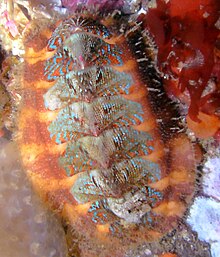
Chitons are marine molluscs of varying size in the class Polyplacophora, formerly known as Amphineura. About 940 extant and 430 fossil species are recognized.

The gumboot chiton also known as the giant western fiery chiton, is the largest of the chitons, growing to 36 cm (14 in) and over 2 kg (4.4 lb). It is found along the shores of the northern Pacific Ocean from Central California to Alaska, across the Aleutian Islands to the Kamchatka Peninsula and south to Japan. It inhabits the lower intertidal and subtidal zones of rocky coastlines.

Eudoxochiton nobilis, commonly called the noble chiton, is a large chiton of the family Callochitonidae. Māori name is Rangitīra.
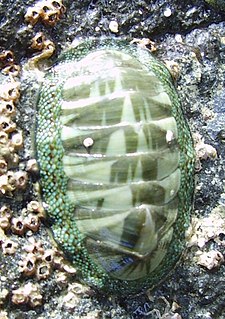
Chiton glaucus, common name the green chiton or the blue green chiton, is a species of chiton, a marine polyplacophoran mollusk in the family Chitonidae, the typical chitons. It is the most common chiton species in New Zealand. Chiton glaucus is part of a very primitive group of mollusc with evidence of being present in up to 80 million years of the fossil record.

Acanthochitona zelandica is a species of chiton in the family Acanthochitonidae, also sometimes known as the hairy, or "tufted," chiton. It probably developed during the mid to late Pleistocene, and is endemic to New Zealand.

Tonicella lineata, commonly known as the lined chiton, is a species of chiton from the North Pacific.

Tonicella undocaerulea, commonly known as the blue lined chiton, is a species of chiton.
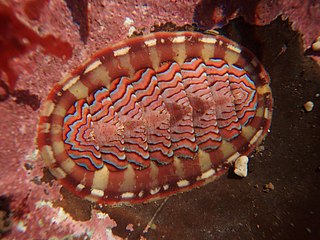
Tonicella lokii, commonly known as the flame lined chiton or Loki's chiton, is a chiton in the lined chiton genus Tonicella.

Mopalia muscosa, the mossy chiton, is a species of chiton, a polyplacophoran, an eight-plated marine mollusk. It is a northeastern Pacific species which occurs from British Columbia, Canada, to Baja California Mexico.

Mopalia hindsii is a species of medium-sized chiton that grows up to 7 cm long. Most commonly found in intertidal zones, M. hindsii has a white ventral side unlike most intertidal chitons that are orange underneath.

Chiton tuberculatus, the West Indian Green Chiton, is a species of chiton, a marine polyplacophoran mollusk in the family Chitonidae, the typical chitons.
Mopalia ciliata is a chiton in the genus Mopalia, commonly known as the hairy chiton. It is a medium-sized marine mollusc up to 5.0 cm in length. It is oval shaped with 8 separate moderately elevated, overlapping ridged valves on its dorsal surface. It resides along the coast of North America.

Katharina tunicata is commonly known as the black Katy chiton, black Leather chiton, black chiton, or leather chiton is a species of chiton in the family Mopaliidae.

Acanthochitona fascicularis is a common chiton in the family Acanthochitonidae.
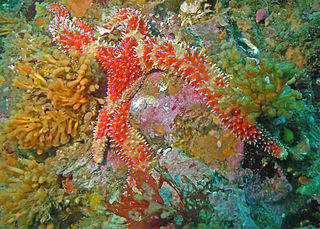
Orthasterias is a genus of sea stars in the family Asteriidae. Orthasterias koehleri, the rainbow star or red-banded sea star, is the only species in the genus. It is found in the North Pacific Ocean.

Plaxiphora tricolor is a species of chiton in the family Mopaliidae.
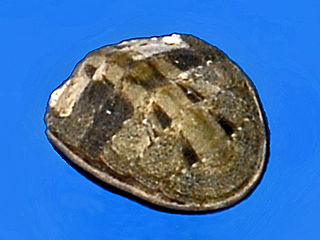
Cyanoplax hartwegii is a species of chiton in the family Lepidochitonidae.

Acanthochitona garnoti, the spiny chiton, is a medium-sized polyplacophoran mollusc in the family Acanthochitonidae, found on the coast of southern Africa.

Tonicella insignis, White-lined chiton, or Red chiton, also known as the hidden chiton, belongs to the Tonicellidae family in the class of Polyplacophora, and the phylum of Mollusca. Its body length of T. insignis is around 5 cm.

Tonicella marmorea is a species of chiton, a polyplacophoran mollusc found in the Arctic Ocean and the North Atlantic Ocean. It was first described by the Danish missionary and naturalist Otto Fabricius.
